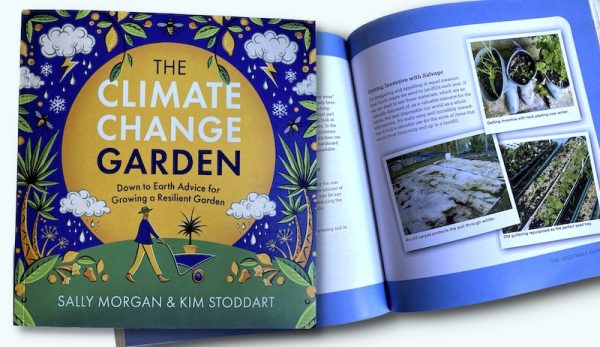
Gardening has always had its challenges—like the time the raccoons got most of my sweet corn. (The fuzzy vandals had taken a few bites out of each ear and then just cast them aside with little regard for all of my hard work.) But I’ve noticed that—little by little and year after year—gardening seems to have become even more challenging.
Many gardeners now must contend with more extreme weather events, extended periods of heat and drought, unchecked insect pests and many other climate change-related troubles.
But that doesn’t mean we need to give up on our gardens. The Climate Change Garden: Down to Earth Advice for Growing a Resilient Garden, co-authored by Sally Morgan and Kim Stoddart, aims to help gardeners everywhere to become more climate-wise—and to grow more resilient gardens as a result.
Based in Somerset, England, Morgan operates a 100-acre certified organic farm. She’s also edited the U.K.-based Organic Farming magazine for the last decade.
“My time with Organic Farming has brought me into contact with some inspiring farmers and growers,” she says. “Looking around their holdings and attending conferences, such as the Oxford Real Farming Conference, has given me new insights on how they cope with the extremes of climate.”
Those insights helped to inform The Climate Change Garden. According to Morgan, a couple of keys to more resilient gardens include developing healthy soil and a healthy soil food web—both of which can help to mitigate the effects of today’s “topsy-turvey climate.”
Read more: Prepare your farm for climate change with these tips!
Do Not Disturb!
“I’ve not dug my soils for 20 years or more,” she notes. “Instead, [I] have moved to no-till, where the soil is left undisturbed as much as possible.”
But what if you have your heart set on turning over your garden beds each season? “For those who still like digging, I point out that every time you bring soil to the surface, some of the carbon is lost,” Morgan says.
That newly released carbon contributes to the warming of the planet. What’s more, Morgan continues, “The soil structure is disrupted, and you lose water retention capacity. [Digging also] damages the network of fungal hyphae in the soil that are so important for plant health.”
Digging also brings weed seeds up to the surface where they’re more likely to sprout. This, in turn, necessitates more work from you—removing the unwanted plants. To keep weeds down, lock in moisture and protect the soil, Morgan recommends adding a thin layer of compost to your gardens in the fall, as well as mulching during the summer.
Extra Protection
Morgan further protects her soil by growing living mulches like clover and nasturtiums underneath her crops. She explains, “[Living mulches are] low-growing, carpeting species.”
(Not only does clover fix nitrogen in the soil, but its flowers, along with the nasturtiums, attract pollinators.)
She continues, “I am pretty relaxed about some annual weeds, too. I don’t tend to worry about the smaller weeds, especially if they have flowers that support pollinators.”
Some of the weeds she actually welcomes include ground ivy (Glechoma hederacea), chickweed (Stellaria media) and red dead nettle (Lamium purpureum). “They produce lots of flowers, are not competitive with crops, and are easy to remove if necessary,” Morgan says.
But what if weeds do start to overwhelm the garden? Morgan generally cuts them off with a sharp hoe, leaving their root systems intact. “I always leave roots of large weeds in the ground wherever possible, so they decay and add nutrients to the soil,” she says.
Read more: The Living Soil Handbook is an important guide for no-till growers.
Greater Biodiversity
Besides preserving the health and integrity of our topsoil, we also need to encourage more diversity in our gardens if we are to prevail as gardeners in the near future. “The more diverse the crops, the more varieties within a crop. [And the more we use] companion plants, the more resilient the garden,” Morgan says.
Certain crops may fail due to increased numbers of certain insect pests or, say, extra soggy growing conditions. But, provided you’ve hedged your bets with multiple varieties, others may survive.
Climate-wise gardeners should also grow more perennial veggies like leeks, onions and asparagus.
“They definitely save time—no sowing seeds, potting, transplanting, etc.—and often provide a crop during the winter and early spring when other crops [have yet] to get going,” Morgan says. “The soil under these perennials is undisturbed, of course. So, that helps conserve moisture while their leaves add a mulch to the surface. [That’s a] win-win.”
Cool Springs Press is set to release The Climate Change Garden: Down to Earth Advice for Growing a Resilient Garden in February 2023.




